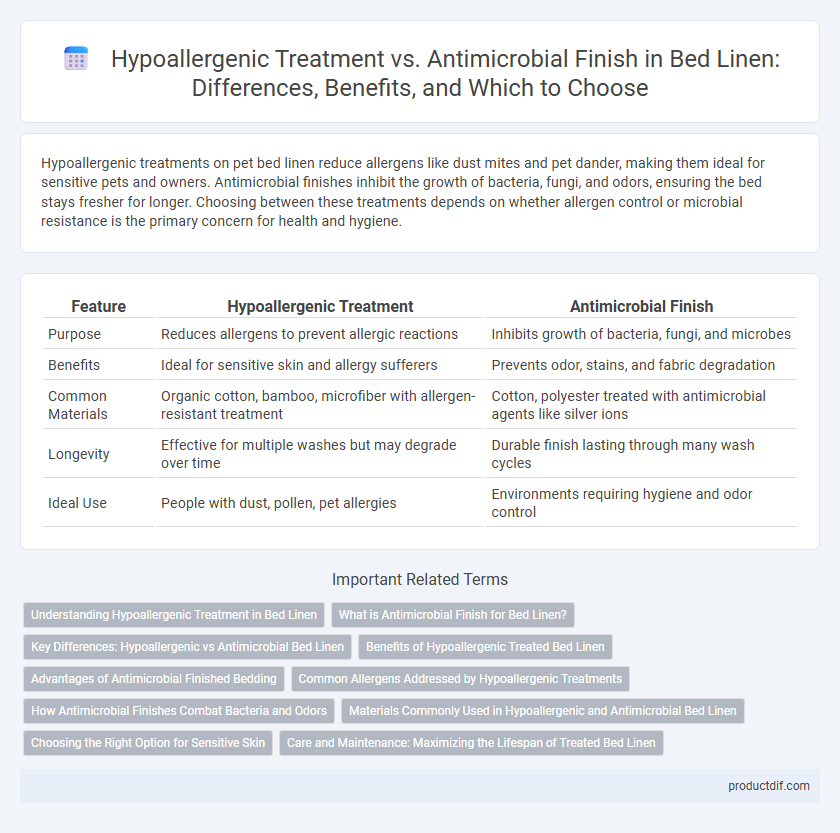Hypoallergenic treatments on pet bed linen reduce allergens like dust mites and pet dander, making them ideal for sensitive pets and owners. Antimicrobial finishes inhibit the growth of bacteria, fungi, and odors, ensuring the bed stays fresher for longer. Choosing between these treatments depends on whether allergen control or microbial resistance is the primary concern for health and hygiene.
Table of Comparison
| Feature | Hypoallergenic Treatment | Antimicrobial Finish |
|---|---|---|
| Purpose | Reduces allergens to prevent allergic reactions | Inhibits growth of bacteria, fungi, and microbes |
| Benefits | Ideal for sensitive skin and allergy sufferers | Prevents odor, stains, and fabric degradation |
| Common Materials | Organic cotton, bamboo, microfiber with allergen-resistant treatment | Cotton, polyester treated with antimicrobial agents like silver ions |
| Longevity | Effective for multiple washes but may degrade over time | Durable finish lasting through many wash cycles |
| Ideal Use | People with dust, pollen, pet allergies | Environments requiring hygiene and odor control |
Understanding Hypoallergenic Treatment in Bed Linen
Hypoallergenic treatment in bed linen involves using materials and processes that minimize allergens such as dust mites, pet dander, and pollen, reducing the risk of allergic reactions for sensitive sleepers. This treatment often incorporates tightly woven fabrics and special finishes that prevent allergen accumulation and promote breathability, enhancing overall sleep hygiene. Unlike antimicrobial finishes that target bacteria and fungi, hypoallergenic treatments specifically aim to limit exposure to common airborne allergens, ensuring a healthier sleeping environment.
What is Antimicrobial Finish for Bed Linen?
Antimicrobial finish for bed linen involves applying a protective coating that inhibits the growth of bacteria, mold, and mildew, enhancing hygiene and prolonging fabric life. This treatment uses silver ions or other biocidal agents embedded in the fibers to reduce odors and prevent microbial contamination. Unlike hypoallergenic treatments that target allergens, antimicrobial finishes specifically combat microbes, ensuring cleaner and fresher bedding.
Key Differences: Hypoallergenic vs Antimicrobial Bed Linen
Hypoallergenic bed linen undergoes a treatment designed to minimize allergens such as dust mites, pet dander, and pollen, making it ideal for sensitive skin and allergy sufferers. Antimicrobial finished bed linen contains agents that inhibit the growth of bacteria, fungi, and odors, promoting hygiene and reducing the risk of infections. While hypoallergenic focuses on preventing allergic reactions by reducing irritants, antimicrobial finishes actively target microbial contamination to enhance cleanliness and longevity.
Benefits of Hypoallergenic Treated Bed Linen
Hypoallergenic treated bed linen significantly reduces the risk of allergic reactions by minimizing exposure to common allergens such as dust mites, pet dander, and pollen. This treatment enhances comfort for sensitive skin and asthma sufferers by creating a barrier against irritants, contributing to improved sleep quality and overall health. Unlike antimicrobial finishes that primarily inhibit bacterial growth, hypoallergenic treatment specifically targets allergens, offering specialized protection for allergy-prone individuals.
Advantages of Antimicrobial Finished Bedding
Antimicrobial finished bedding offers superior protection against bacteria, mold, and dust mites, enhancing hygiene and reducing odors for a fresher sleep environment. This treatment extends the lifespan of bed linen by preventing microbial growth that can degrade fabric fibers. Unlike hypoallergenic treatments that primarily reduce allergens, antimicrobial finishes actively inhibit the proliferation of harmful microorganisms, contributing to improved health and comfort.
Common Allergens Addressed by Hypoallergenic Treatments
Hypoallergenic treatments target common allergens such as dust mites, pet dander, mold spores, and pollen, reducing their presence in bed linen to minimize allergic reactions. These treatments create a barrier that prevents allergen accumulation, enhancing sleep quality for sensitive individuals. Unlike antimicrobial finishes that inhibit microbial growth, hypoallergenic treatments specifically focus on neutralizing allergens that trigger respiratory and skin irritations.
How Antimicrobial Finishes Combat Bacteria and Odors
Antimicrobial finishes on bed linen work by inhibiting the growth and reproduction of bacteria, mold, and fungi through the use of silver ions or other biocidal agents embedded in the fabric. These finishes disrupt microbial cell functions, reducing odors caused by bacterial activity and extending the freshness and hygiene of sheets and pillowcases. Compared to hypoallergenic treatments, antimicrobial finishes actively prevent bacteria buildup, providing continuous odor control and improved sleep environment quality.
Materials Commonly Used in Hypoallergenic and Antimicrobial Bed Linen
Hypoallergenic bed linen typically features natural fibers such as organic cotton, bamboo, and Tencel, which resist dust mites and allergens due to their breathable properties. Antimicrobial finishes often incorporate synthetic treatments like silver ions or copper-infused fibers that inhibit bacterial growth and odor. Combining natural hypoallergenic materials with advanced antimicrobial technologies enhances both comfort and hygiene in bedding products.
Choosing the Right Option for Sensitive Skin
Hypoallergenic treatment in bed linen minimizes allergens like dust mites and pollen, making it ideal for sensitive skin prone to allergies and irritation. Antimicrobial finishes inhibit the growth of bacteria and fungi, reducing odor and potential skin infections while offering longer-lasting freshness. For individuals with sensitive skin, selecting hypoallergenic linens ensures reduced allergic reactions, whereas antimicrobial finishes provide enhanced protection against microbial buildup, supporting skin health in different ways.
Care and Maintenance: Maximizing the Lifespan of Treated Bed Linen
Hypoallergenic treatment reduces allergens by using gentle, chemical-free processes, requiring regular washing with mild detergents to preserve fabric softness and efficacy. Antimicrobial finish inhibits bacterial growth through embedded agents, needing careful laundering to avoid harsh chemicals and high temperatures that may degrade the protective layer. Proper care, including gentle cycles and avoiding bleach, maximizes the lifespan and maintains the functional properties of both treated bed linens.
Hypoallergenic Treatment vs Antimicrobial Finish Infographic

 productdif.com
productdif.com